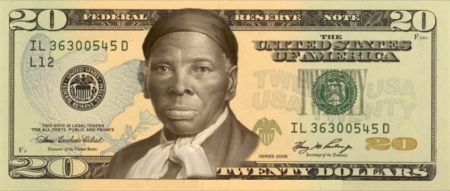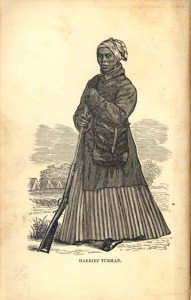


05/15/2015
See earlier: “It’s Time” — For Affirmative-Action Currency To Symbolize Affirmative-Action Post-America
See later: The Tubman Turncoats: Cuckservatism Inc. Has Learned To Love Big Sister

This campaign for Harriet Tubman to replace Andrew Jackson on the $20 dollar bill is because she’s such important figure in American history, right? If you attend an American public school, very important. Tubman was already in the textbooks when Steve Sailer was going through school in the ‘70s. In 1994, Lynne Cheney complained that the National History Standards gave equal weight to Tubman and George Washington (remember him?) [The End of History, Wall Street Journal October 20, 1994]. Surely she couldn’t be a myth?
Instapundit put it this way recently
POLL: Put Harriet Tubman On The $20 Bill.Sure, why not? Get rid of that mass-murdering Democrat Andrew Jackson, and replace him with a gun-toting Republican!
Well, that’s one way of describing her.
By VDARE.com Editor Peter Brimelow has been listening to historian James McPherson’s This Mighty Scourge: Perspectives on the Civil War audiobook, and he was surprised by the very respectable McPherson’s cool treatment of Harriet Tubman. McPherson’s essay was adapted from his 2004 story in the New York Review of Books, The Moses Of Her People [March 11, subscriber link. My quotes are from this version.]

Tubman remained illiterate her whole life. Her 1869 “biography,” Scenes in the Life of Harriet Tubman, was actually written by a white friend named Sarah Bradford, who also wrote Harriet — The Moses of Her People, in 1886. There are only four letters of Tubman’s in existence, and they were dictated.
McPherson writes:
Like Betsy Ross, Tubman had achieved mythical stature because of her conspicuous place in school textbooks and children’s stories about heroic Americans. The legendary "Moses" of her people, who escaped from slavery in 1849 and returned to Maryland again and again to lead three hundred more slaves to freedom, she also served as a scout during the Civil War and led Union soldiers on raids into the South Carolina interior to liberate hundreds more slaves. For children black or white, Hispanic or Indian, immigrant or native-born, these stories of risk and adventure propelled Tubman ahead of Davy Crockett and Nathan Hale and put her right up there with Meriwether Lewis and William Clark.
McPherson then quietly reveals that much of this is, indeed, myth.
In the last 60 years there have been many books about Tubman for children, but there hadn’t been any professional biographies until a few years ago, which is what McPherson’s 2004 review was about. (The biographies are Harriet Tubman: The Life and the Life Stories by Jean M. Humez, Bound for the Promised Land: Harriet Tubman, Portrait of an American Hero, and Harriet Tubman: The Road to Freedom by Catherine Clinton, and according to McPherson, publicists for each of them, published almost simultaneously, claimed theirs to be the first "major biography" in sixty years.)
He writes:

Many of the incidents of her life as a slave, as a fugitive escaping to freedom, and as the "Moses" who returned repeatedly to lead others out of bondage are derived from her own testimony and often impossible to corroborate from other sources. Problems of evidence present formidable obstacles to biographers intent on sifting reality from myth. All three biographies under review were written by careful scholars with high standards. Even so, there are puzzling anomalies in the story of Tubman’s life.
Such as:
Wikipedia refers to Tubman’s threats this way: “Tubman told the tale of one man who insisted he was going to go back to the plantation when morale got low among a group of fugitive slaves. She pointed the gun at his head and said, ‘You go on or die.’”[Accessed May 15, 2015] That’s the 2015 version — almost every time it was quoted before that, including in the Negro Digest in 1965, she said “Dead n*ggers tell no tales; you go on or die!”
This was less noticeable during the 1860s, when people were more religious, but here’s how McPherson puts it:
During these seizures she often experienced dreams or visions, even hallucinations, sometimes with powerful religious overtones — more than once she said that God had spoken to her.
The mythological nature of much of the Tubman narrative was acknowledged by the Washington Post in a story two years ago by black reporter Krissah Thompson, who has her own way of dealing with the Deplorable Word in that quote above:
Abolitionists claimed there was once a $40,000 bounty on Tubman’s head. But records of wanted ads show that a reward of $50 was offered for her return if she was found in the state of Maryland and $100 outside the state. And Tubman is often depicted as old and stooped, but she was in her late 20s and early 30s while helping others, largely family and friends, escape bondage. Her husband, John, refused to leave with her. He had taken up with another woman.Tubman told Bradford about having to pull out the revolver she carried to persuade some who followed her north to press on, despite their exhaustion. While pointing it at their heads she would say, “Dead [men] tell no tales; you go on or die!”
True story or exaggeration? Hard to know.
A century after Harriet Tubman died, scholars try to separate fact from fiction, By Krissah Thompson, Washington Post, March 9, 2013
One reason for the Tubman boom: the trend of promoting antiquarian hate against whites for hundred-year-old racism and for slavery abolished a hundred and fifty years ago.
But there’s also another, sad reason: there are so few black heroes and heroines, and they have to take what they can get.
But does the rest of America have to put up with it on the $20 dollar bill?

A final point: how did the modern Harriet Tubmania get started? McPherson explains:
For decades after her death in 1913 at the probable age of ninety (her exact birth date is unknown), Tubman languished in obscurity. The only African-Americans who enjoyed historical fame in those years were George Washington Carver and Booker T. Washington. In the 1930s the labor activist Earl Conrad (Earl Cohen) decided to write a biography of Tubman.
Milton Sennett’s 2007 book Harriet Tubman: Myth, Memory, and History, says that while mainstream publishers “ignored Harriet Tubman, interest in her was being cultivated by left-wing organizations, specifically ones connected with the radical labor movement.”
The “radical labor movement” and “labor activist Earl Conrad” both mean “Communist”, by the way. The Russian-controlled Communist Party of the USA was active in “civil rights” in the old days, for reasons of its own. That’s where the modern Tubman boom started.
Of course, we’re not supposed to Notice this. But if Tubman were being promoted by conservatives and patriots, we’d sure be hearing a lot about “tainted sources” and “ugly roots.”
James Fulford is a writer and editor for VDARE.com.